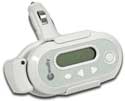
PodFM
Company: MacAlly
Price: $50 US
http://www.macally.com/spec/ipod/podfmtf.html
While Captain David Weeks was testing his MacAlly BlueWave wireless stereo headphones in the cabin of an Airbus at 37,000 feet, the Nemo family was evaluating MacAlly’s PodFM in a lime green Volkswagen Beetle at an elevation below sea level on California’s Interstate 8 expressway. I don’t know what FCC frequency David’s jet was using, but Barbara and I were grooving at 88.5 on the FM dial, thanks to the versatile PodFM.
This strange-looking and slightly-bizarro (at first) device sends the audio signal from your iPod to your car’s FM radio, similarly to Belkin’s TuneBase reviewed by Guy Serle. I urge you to read Guy’s explanation of how FM transmission works, to help you understand the limitations we experienced.
Prior to using PodFM, I was satisfied with the audio quality of my iPod when tethered to either of my cars’ cassette players via a $20 Sony generic audio adapter. (MacAlly also sells such an adapter.) If PodFM could produce iPod audio that is as listenable as from a cassette adapter, minus any obnoxious or distracting wires, $50 US would be a small price to pay for a frequent Podder such as Nemo.
PodFM was designed by a committee, because none of its several components appears to be compatible with any of the others, at first glance. After observing each piece from every direction, I wished us luck as we headed from Arizona to California for our summer vacation. With 1,104 miles of successful PodFM usage (give or take a metropolis or two), I’m pleased with the results, and Barbara is overjoyed (she’s more particular about cables than I am).
Here’s how it works. Make sure PodFM’s transmitter is plugged fully into its adjustable cradle, and then firmly insert this combo unit into a convenient cigarette lighter holder in your vehicle. On our New Beetle, this location is under the tiltable armrest dividing front passenger seats, handy for both driver and passenger. Press PodFM’s power button, switch on your car radio, navigate both radio and PodFM (via triangular up or down buttons) to a vacant radio frequency, connect iPod (or other portable music player) to PodFM via a clever retractable headphone jack cable, start your iPod playing, set your iPod and radio volume controls, and listen to the latest MyMac.com podcast without a care in the world at 70 miles per hour (preferably on the expressway).
Reading the above makes the procedure appear to be complicated, but it’s not. FM station compatibility is the only unpredictable factor, and when you’re in a desert environment with hundreds of miles between cities, as we were much of our trip, most of the FM band was empty (and I won’t be making any wisecracks about the religious and Spanish language/music stations that appear much more often than do broadcasts of Britain’s National Theatre or NPR’s Daniel Schorr, not to mention Miles Davis, Little Richard, or Joni Mitchell — for them you’ll need to subscribe to a commercial satellite radio network and have a fashionable black blob affixed to the top rear of your car’s roof).
IMPORTANT: If you live or drive most of the time in a heavily populated (both with people and radio stations) area, PodFM works best when one or more FM frequencies is vacant of regular radio stations. Otherwise, interference can be annoying, and at times infuriating.
MORE IMPORTANT: When driving alone, perform all tuning adjustments when at a full stop. MyMac.com and MacAlly will not pay your hospital or car repair bills!
If your car has a built-in cassette player and you don’t mind a cable that’s always in the wrong place, PodFM’s benefits won’t attract you. But if either of the above is not the case, MacAlly may have you as a customer sooner or later. Because when locked into an empty frequency, PodFM+iPod produce darn good sound that will vary from radio to radio and from song to song, but is always acceptable to everyone except the most serious audiophile for an irreverent description).
P.S. Learn to use your iPod’s built-in equalizer, and send me a thank you note.
But wait, there’s more! PodFM ships with an adapter than can power and charge your iPod whether or not it’s playing at that moment. I experienced some white noise or static when my iPod was active with the charger attached, and your experience may be different, but the charger is a handy addition to the package and it does work as advertised. And, yes more again, you can extract PodFM’s transmitter from its cradle, plug an included AC-to-USB (a first in my experience) adapter into the transmitter, locate an available frequency on your home stereo FM receiver or tuner, and listen to your iPod vid PodFM in your house, wirelessly. I’m doing just that now, and audio quality is fine, given the “MP3—192†compression on my songs.
MyMac.com’s Tim Robertson spoke at length about audio quality using this technology in recent Podcasts, and I agree with Tim’s conclusion: nothing compares to uncompressed music from a CD for finest quality, but iPod-to-house-FM can be convenient for casual listening.
Go to PodFM’s specs page for photos and descriptions, and consider whether this innovative device is suitable for your use. For Barbara and me, PodFM solved many more problems than it caused by occasional interference in urban areas, and for Podders without cassette adapters who like their tunes plentiful and mobile, MyMac.com gives the MacAlly 4 out of 5 for PodFM.

Leave a Reply
You must be logged in to post a comment.